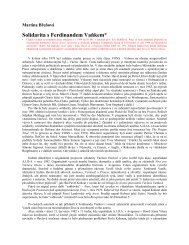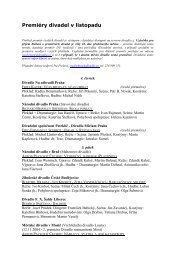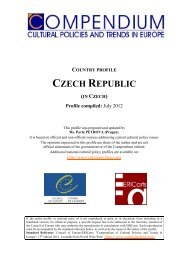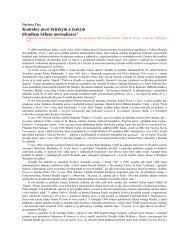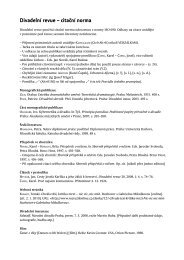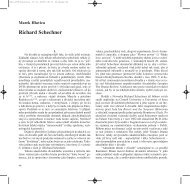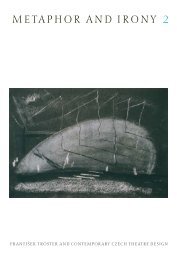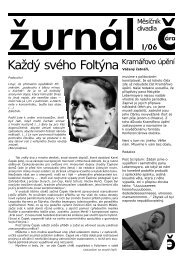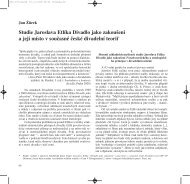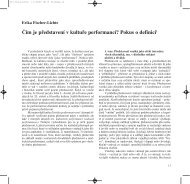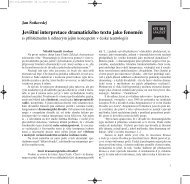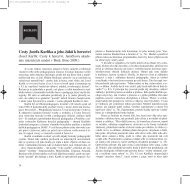concept for more efficient support of the arts in 2007–2013 - Divadlo.cz
concept for more efficient support of the arts in 2007–2013 - Divadlo.cz
concept for more efficient support of the arts in 2007–2013 - Divadlo.cz
You also want an ePaper? Increase the reach of your titles
YUMPU automatically turns print PDFs into web optimized ePapers that Google loves.
Part A<br />
AN ANALYSIS OF THE CURRENT SITUATION<br />
1. Recent Basic Developmental Trends<br />
and Their Evaluation<br />
S<strong>in</strong>ce 1989 <strong>the</strong> <strong>arts</strong> have experienced dramatic changes <strong>in</strong> connection with <strong>the</strong> general<br />
post-Communist trans<strong>for</strong>mation <strong>of</strong> society and <strong>the</strong> accompany<strong>in</strong>g processes <strong>of</strong> <strong>the</strong> restitution<br />
and privatisation <strong>of</strong> property, <strong>the</strong> trans<strong>for</strong>mation or dissolution <strong>of</strong> artistic organisations, and <strong>the</strong><br />
essentially spontaneous <strong>for</strong>mation <strong>of</strong> a new <strong>in</strong>frastructure through civic <strong>in</strong>itiatives and bus<strong>in</strong>ess<br />
projects, all <strong>of</strong> which occurr<strong>in</strong>g with<strong>in</strong> a new legislative framework. At <strong>the</strong> start <strong>of</strong> <strong>the</strong> 1990s cultural<br />
heritage was made a priority, <strong>in</strong> particular <strong>the</strong> conservation <strong>of</strong> cultural monuments, which<br />
at that time were <strong>in</strong> a derelict state, and <strong>the</strong> <strong>arts</strong> were largely guided by ef<strong>for</strong>ts to annul and elim<strong>in</strong>ate<br />
8 <strong>the</strong> adm<strong>in</strong>istrative obstacles to artistic work. Without anyth<strong>in</strong>g aris<strong>in</strong>g to replace <strong>the</strong>m,<br />
<strong>the</strong> monopolistic bodies and regulatory mechanisms that until 1989 had provided <strong>the</strong> f<strong>in</strong>ancial<br />
resources <strong>for</strong> re<strong>in</strong>vestment and <strong>for</strong> f<strong>in</strong>anc<strong>in</strong>g <strong>of</strong> projects with<strong>in</strong> <strong>the</strong> <strong>in</strong>tegrated and centrally controlled<br />
systems <strong>of</strong> <strong>in</strong>dividual artistic sectors were abolished.<br />
The Rise <strong>of</strong> Civic Associations<br />
A key turn<strong>in</strong>g po<strong>in</strong>t <strong>in</strong> <strong>the</strong> sphere <strong>of</strong> culture and <strong>the</strong> <strong>arts</strong> was <strong>the</strong> <strong>in</strong>troduction <strong>of</strong> <strong>the</strong> new<br />
Act No. 83/1990 Coll. on <strong>the</strong> Association <strong>of</strong> Citizens, which laid <strong>the</strong> foundations <strong>for</strong> <strong>the</strong> establishment<br />
<strong>of</strong> a civil society and made it possible <strong>for</strong> cultural and artistic civic associations to be<br />
founded. An important step towards “de-nationalis<strong>in</strong>g” culture and <strong>the</strong> <strong>arts</strong> was <strong>the</strong> emergence<br />
<strong>of</strong> private legal entities <strong>in</strong> this sphere, whose activities are regulated under Act No. 455/1991<br />
Coll. on Small Bus<strong>in</strong>ess (<strong>the</strong> Small Bus<strong>in</strong>esses Act), as subsequently amended, and Act No.<br />
513/1991 Coll., <strong>the</strong> Commercial Code, as subsequently amended.<br />
The Demise <strong>of</strong> Artistic Unions<br />
One <strong>of</strong> <strong>the</strong> first major changes to occur as part <strong>of</strong> <strong>the</strong> trans<strong>for</strong>mation process <strong>in</strong> <strong>the</strong> field<br />
<strong>of</strong> <strong>the</strong> <strong>arts</strong> was <strong>the</strong> dissolution <strong>of</strong> federal and national artistic unions, membership <strong>in</strong> which had<br />
– <strong>in</strong> some branches – been considered a requirement <strong>in</strong> order <strong>for</strong> an artist to obta<strong>in</strong> pr<strong>of</strong>essional<br />
status. After 1990 new pr<strong>of</strong>essional organisations began to emerge, some <strong>of</strong> which drew on and<br />
revived a pre-war tradition <strong>of</strong> existence as an organisation, e. g. <strong>the</strong> Society <strong>of</strong> Architects (Obec<br />
architektÛ), or renewed <strong>the</strong>ir activities by be<strong>in</strong>g founded anew, like <strong>the</strong> Czech Film and Television<br />
Association (Unie âeského filmové svazu a âeského televizního svazu, FITES), whose predecessor,<br />
<strong>the</strong> Union <strong>of</strong> Czechoslovak Film and Television Artists (Svaz ãs. filmov˘ch a televizních<br />
umûlcÛ, also FITES), had been abolished <strong>in</strong> 1970. The largest artistic community was that <strong>of</strong> <strong>the</strong><br />
visual <strong>arts</strong>, which trans<strong>for</strong>med itself – at a conference and later a special meet<strong>in</strong>g (1990) <strong>of</strong> <strong>the</strong><br />
Union <strong>of</strong> Czech Visual Artists (Svaz ãesk˘ch v˘tvarn˘ch umûlcÛ, SâVU) – <strong>in</strong>to a federation <strong>of</strong> associations,<br />
i. e. pr<strong>of</strong>essional associations def<strong>in</strong>ed by field, region, or <strong>in</strong>terest. The legal successor<br />
to <strong>the</strong> SâVU was <strong>the</strong> Union <strong>of</strong> Visual Artists (Unie v˘tvarn˘ch umûlcÛ, UVU, today UVU âR);<br />
this organisational succession <strong>in</strong>cluded <strong>the</strong> transferral <strong>of</strong> membership <strong>in</strong> <strong>the</strong> International Association<br />
<strong>of</strong> Art IAA/AIAP (UNESCO). By agreement with <strong>the</strong> Slovak Union <strong>of</strong> Visual Arts (Slovenská<br />
v˘tvarná unie, SVU) <strong>the</strong> federal Union <strong>of</strong> Czechoslovak Visual Artists (Svaz ãs. v˘tvarn˘ch<br />
umûlcÛ, SâSVU) was dissolved. Initially <strong>the</strong> visual <strong>arts</strong> community encompassed <strong>the</strong> fields <strong>of</strong><br />
architecture, art restoration and restorers (craftsmen), and art <strong>the</strong>orists and art historians, which<br />
added up to ten thousand people <strong>in</strong> total. The Union embraced a total <strong>of</strong> 70 associations, and<br />
today about one-half <strong>of</strong> <strong>the</strong> artistic community is associated under it. Soon after <strong>the</strong>se changes a<br />
process <strong>of</strong> <strong>in</strong>dividualisation and dis<strong>in</strong>tegration set <strong>in</strong> that has cont<strong>in</strong>ued to date.<br />
In 1992, when <strong>the</strong> process <strong>of</strong> establish<strong>in</strong>g a democratic society was already under way,<br />
<strong>the</strong> pr<strong>in</strong>ciple that began to become apparent <strong>in</strong> <strong>the</strong> <strong>arts</strong> was that it is not <strong>the</strong> state or any <strong>in</strong>dividual<br />
artistic or cultural <strong>in</strong>stitution that are sovereign <strong>in</strong> <strong>the</strong> artistic sphere but ra<strong>the</strong>r <strong>the</strong> <strong>in</strong>dividual<br />
that cultural assets are <strong>in</strong>tended <strong>for</strong>. 9 The pr<strong>in</strong>ciple <strong>of</strong> “de-nationalis<strong>in</strong>g” culture was based on<br />
<strong>the</strong> simple conviction that <strong>the</strong> state should not be runn<strong>in</strong>g <strong>the</strong> <strong>arts</strong>. This idea produced <strong>the</strong> view<br />
that at best <strong>the</strong> state can run national <strong>in</strong>stitutions (e. g. <strong>the</strong> National Theatre, <strong>the</strong> National Gallery<br />
<strong>in</strong> Prague, <strong>the</strong> Czech Philharmonic Orchestra, <strong>the</strong> National Film Archives, <strong>the</strong> Museum <strong>of</strong> Applied<br />
Arts <strong>in</strong> Prague, <strong>the</strong> Museum <strong>of</strong> Czech Literature, <strong>the</strong> National Library <strong>of</strong> <strong>the</strong> Czech Republic)<br />
and control over everyth<strong>in</strong>g else should be ceded to <strong>the</strong> control <strong>of</strong> <strong>the</strong> municipalities (later<br />
also <strong>the</strong> regions) and to civic actions and <strong>in</strong>itiatives. In <strong>the</strong> mid-1990s programmes and systems<br />
<strong>for</strong> subsidis<strong>in</strong>g <strong>the</strong> <strong>arts</strong> began to be <strong>for</strong>malised at <strong>the</strong> state level, but <strong>the</strong> <strong>for</strong>m <strong>of</strong> this <strong>support</strong><br />
was project-based and not <strong>in</strong>stitutionalised. The majority <strong>of</strong> <strong>the</strong> f<strong>in</strong>ancial resources go<strong>in</strong>g <strong>in</strong>to<br />
<strong>support</strong> <strong>for</strong> <strong>the</strong> <strong>arts</strong> were still provided through governmental organisations <strong>of</strong> <strong>the</strong> M<strong>in</strong>istry <strong>of</strong><br />
Culture (hereafter “MC”).<br />
The Trans<strong>for</strong>mation <strong>of</strong> Individual Artistic Organisations<br />
The trans<strong>for</strong>mation <strong>of</strong> artistic organisations commenced at <strong>the</strong> start <strong>of</strong> <strong>the</strong> 1990s and <strong>in</strong>volved<br />
<strong>the</strong> privatisation and liquidation <strong>of</strong> a large number <strong>of</strong> organisational entities. Publishers and<br />
<strong>in</strong>stitutions engaged <strong>in</strong> <strong>the</strong> production <strong>of</strong> music and film were privatised <strong>in</strong> <strong>the</strong> first wave <strong>of</strong> privatisation.<br />
In <strong>the</strong> fields <strong>of</strong> <strong>the</strong>atre and music, after privatisation and <strong>the</strong> subsequent change <strong>of</strong><br />
found<strong>in</strong>g party, <strong>the</strong> orig<strong>in</strong>al network <strong>of</strong> <strong>the</strong>atres and symphonic orchestras was left almost <strong>in</strong>tact,<br />
and <strong>in</strong> some cases even <strong>the</strong> governmental organisations were trans<strong>for</strong>med <strong>in</strong>to o<strong>the</strong>r types <strong>of</strong> entities,<br />
whereby gradually new types <strong>of</strong> private legal entities were added to <strong>the</strong> orig<strong>in</strong>al network.<br />
The visual <strong>arts</strong> underwent a similarly complex process <strong>of</strong> trans<strong>for</strong>mation and development.<br />
- Visual Arts<br />
A good number <strong>of</strong> organisations and enterprises <strong>in</strong> <strong>the</strong> field <strong>of</strong> visual <strong>arts</strong>, architecture, and<br />
design were privatised; <strong>for</strong> example, <strong>the</strong> <strong>for</strong>mer state enterprises ARTIA, Exhibition Management<br />
(V˘stavnictví), Technoart, Dizart, Artcentrum, Institute <strong>of</strong> Folk Art (ÚLUV), Brno Arts and Crafts<br />
(Umûlecká fiemesla Brno), or Arts and Crafts Central Prague (Ústfiedí umûleck˘ch fiemesel Praha).<br />
The privatisation and restitution <strong>of</strong> <strong>the</strong> national cha<strong>in</strong> <strong>of</strong> galleries called Work (Dílo) led to its<br />
demise, which, given that this cha<strong>in</strong> <strong>of</strong> galleries had previously functioned as a plat<strong>for</strong>m <strong>for</strong> <strong>the</strong><br />
exhibition and distribution <strong>of</strong> contemporary art, gave rise to a problem that has yet to be addressed.<br />
As a consequence, <strong>in</strong> <strong>the</strong> early 1990s, art suddenly became relegated to <strong>the</strong> space <strong>of</strong> governmental,<br />
i. e. public-type, museums and galleries, whereby <strong>the</strong> unique role played by galleries <strong>in</strong> identify<strong>in</strong>g<br />
and distribut<strong>in</strong>g works <strong>of</strong> art, through <strong>the</strong>ir sale <strong>of</strong> works to private owners and public collections<br />
and through <strong>the</strong> provision <strong>of</strong> organisational services <strong>for</strong> artists, as is <strong>the</strong> custom elsewhere<br />
<strong>in</strong> <strong>the</strong> world, was stifled. Galleries that organise exhibitions <strong>for</strong> artists and mediate <strong>the</strong> sale <strong>of</strong><br />
<strong>the</strong>ir works had yet to be established and <strong>the</strong>y were to emerge purely <strong>in</strong> con<strong>for</strong>mity with market<br />
pr<strong>in</strong>ciples and with practically no chance <strong>of</strong> <strong>support</strong>. This, toge<strong>the</strong>r with <strong>the</strong> trans<strong>for</strong>mation <strong>of</strong><br />
<strong>the</strong> fund that previously adm<strong>in</strong>istrated <strong>the</strong> property <strong>of</strong> <strong>the</strong> artistic community, as described on <strong>the</strong><br />
follow<strong>in</strong>g pages, seriously complicated fur<strong>the</strong>r development <strong>in</strong> <strong>the</strong> visual <strong>arts</strong> (see page 22).<br />
8 Based on a Government declaration made by Prime M<strong>in</strong>ister Petr Pithart on 2 nd June 1990. 9 From a Government declaration made by Prime M<strong>in</strong>ister Václav Klaus on 13 th July 1992.<br />
16<br />
17



